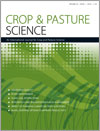CP11320 Break-crop benefits to wheat in Western Australia – insights from over three decades of research
Wheat is the dominant winter crop in Australia, and growers are constantly considering – what is the best rotation to maximise the yield of wheat in a sustainable fashion? Over 160 experiments addressing this question have been conducted in Western Australia since 1974, finding that the highest wheat yields usually follow a break crop such as lupin, field pea or canola. The review provides a useful summary of a large number of experiments which can help growers and their advisers plan rotations to achieve yield, economic and sustainability goals.




